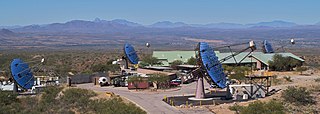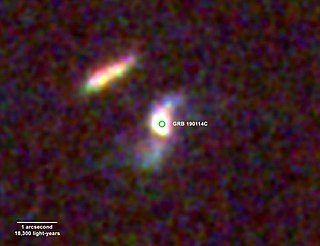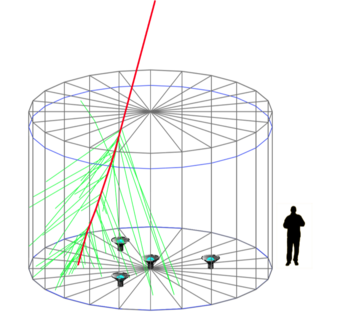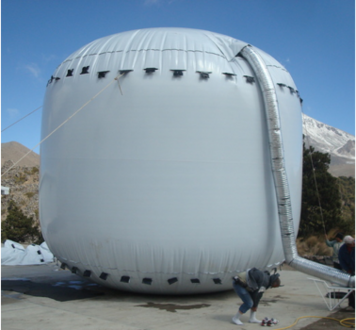
Cosmic rays or astroparticles are high-energy particles or clusters of particles that move through space at nearly the speed of light. They originate from the Sun, from outside of the Solar System in our own galaxy, and from distant galaxies. Upon impact with Earth's atmosphere, cosmic rays produce showers of secondary particles, some of which reach the surface, although the bulk are deflected off into space by the magnetosphere or the heliosphere.
The Greisen–Zatsepin–Kuzmin limit (GZK limit or GZK cutoff) is a theoretical upper limit on the energy of cosmic ray protons traveling from other galaxies through the intergalactic medium to our galaxy. The limit is 5×1019 eV (50 EeV), or about 8 joules (the energy of a proton travelling at ≈ 99.99999999999999999998% the speed of light). The limit is set by the slowing effect of interactions of the protons with the microwave background radiation over long distances (≈ 160 million light-years). The limit is at the same order of magnitude as the upper limit for energy at which cosmic rays have experimentally been detected, although indeed some detections appear to have exceeded the limit, as noted below. For example, one extreme-energy cosmic ray, the Oh-My-God Particle, which has been found to possess a record-breaking 3.12×1020 eV (50 joules) of energy (about the same as the kinetic energy of a 95 km/h baseball).

A blazar is an active galactic nucleus (AGN) with a relativistic jet directed very nearly towards an observer. Relativistic beaming of electromagnetic radiation from the jet makes blazars appear much brighter than they would be if the jet were pointed in a direction away from Earth. Blazars are powerful sources of emission across the electromagnetic spectrum and are observed to be sources of high-energy gamma ray photons. Blazars are highly variable sources, often undergoing rapid and dramatic fluctuations in brightness on short timescales. Some blazar jets appear to exhibit superluminal motion, another consequence of material in the jet traveling toward the observer at nearly the speed of light.

The Fermi Gamma-ray Space Telescope, formerly called the Gamma-ray Large Area Space Telescope (GLAST), is a space observatory being used to perform gamma-ray astronomy observations from low Earth orbit. Its main instrument is the Large Area Telescope (LAT), with which astronomers mostly intend to perform an all-sky survey studying astrophysical and cosmological phenomena such as active galactic nuclei, pulsars, other high-energy sources and dark matter. Another instrument aboard Fermi, the Gamma-ray Burst Monitor, is being used to study gamma-ray bursts and solar flares.

The Compton Gamma Ray Observatory (CGRO) was a space observatory detecting photons with energies from 20 keV to 30 GeV, in Earth orbit from 1991 to 2000. The observatory featured four main telescopes in one spacecraft, covering X-rays and gamma rays, including various specialized sub-instruments and detectors. Following 14 years of effort, the observatory was launched from Space Shuttle Atlantis during STS-37 on April 5, 1991, and operated until its deorbit on June 4, 2000. It was deployed in low Earth orbit at 450 km (280 mi) to avoid the Van Allen radiation belt. It was the heaviest astrophysical payload ever flown at that time at 16,300 kilograms (35,900 lb).

MAGIC is a system of two Imaging Atmospheric Cherenkov telescopes situated at the Roque de los Muchachos Observatory on La Palma, one of the Canary Islands, at about 2200 m above sea level. MAGIC detects particle showers released by gamma rays, using the Cherenkov radiation, i.e., faint light radiated by the charged particles in the showers. With a diameter of 17 meters for the reflecting surface, it was the largest in the world before the construction of H.E.S.S. II.

The IceCube Neutrino Observatory is a neutrino observatory constructed at the Amundsen–Scott South Pole Station in Antarctica. The project is a recognized CERN experiment (RE10). Its thousands of sensors are located under the Antarctic ice, distributed over a cubic kilometre.

IACT stands for imaging atmosphericCherenkov telescope or technique. It is a device or method to detect very-high-energy gamma ray photons in the photon energy range of 50 GeV to 50 TeV.

VERITAS is a major ground-based gamma-ray observatory with an array of four 12 meter optical reflectors for gamma-ray astronomy in the GeV – TeV photon energy range. VERITAS uses the Imaging Atmospheric Cherenkov Telescope technique to observe gamma rays that cause particle showers in Earth's atmosphere that are known as extensive air showers. The VERITAS array is located at the Fred Lawrence Whipple Observatory, in southern Arizona, United States. The VERITAS reflector design is similar to the earlier Whipple 10-meter gamma-ray telescope, located at the same site, but is larger in size and has a longer focal length for better control of optical aberrations. VERITAS consists of an array of imaging telescopes deployed to view atmospheric Cherenkov showers from multiple locations to give the highest sensitivity in the 100 GeV – 10 TeV band. This very high energy observatory, completed in 2007, effectively complements the Large Area Telescope (LAT) of the Fermi Gamma-ray Space Telescope due to its larger collection area as well as coverage in a higher energy band.

Extragalactic cosmic rays are very-high-energy particles that flow into the Solar System from beyond the Milky Way galaxy. While at low energies, the majority of cosmic rays originate within the Galaxy (such as from supernova remnants), at high energies the cosmic ray spectrum is dominated by these extragalactic cosmic rays. The exact energy at which the transition from galactic to extragalactic cosmic rays occurs is not clear, but it is in the range 1017 to 1018 eV.
Milagro was a ground-based water Cherenkov radiation telescope situated in the Jemez Mountains near Los Alamos, New Mexico at the Fenton Hill Observatory site. It was primarily designed to detect gamma rays but also detected large numbers of cosmic rays. It operated in the TeV region of the spectrum at an altitude of 2530 m. Like conventional telescopes, Milagro was sensitive to light but the similarities ended there. Whereas "normal" astronomical telescopes view the universe in visible light, Milagro saw the universe at very high energies. The light that Milagro saw was about 1 trillion times more energetic than visible light. While these particles of light, known as photons, are the same as the photons that make up visible light, they behave quite differently due to their high energies.
The history of gamma-ray began with the serendipitous detection of a gamma-ray burst (GRB) on July 2, 1967, by the U.S. Vela satellites. After these satellites detected fifteen other GRBs, Ray Klebesadel of the Los Alamos National Laboratory published the first paper on the subject, Observations of Gamma-Ray Bursts of Cosmic Origin. As more and more research was done on these mysterious events, hundreds of models were developed in an attempt to explain their origins.

Gamma-ray astronomy is the astronomical observation of gamma rays, the most energetic form of electromagnetic radiation, with photon energies above 100 keV. Radiation below 100 keV is classified as X-rays and is the subject of X-ray astronomy.

Markarian 501 is a galaxy with a spectrum extending to the highest energy gamma rays. It is a blazar or BL Lac object, which is an active galactic nucleus with a jet that is shooting towards the Earth. The object has a redshift of z = 0.034.
Multi-messenger astronomy is astronomy based on the coordinated observation and interpretation of signals carried by disparate "messengers": electromagnetic radiation, gravitational waves, neutrinos, and cosmic rays. They are created by different astrophysical processes, and thus reveal different information about their sources.
TXS 0506+056 is a very high energy blazar – a quasar with a relativistic jet pointing directly towards Earth – of BL Lac-type. With a redshift of 0.3365 ± 0.0010, it is about 1.75 gigaparsecs from Earth. Its approximate location on the sky is off the left shoulder of the constellation Orion. Discovered as a radio source in 1983, the blazar has since been observed across the entire electromagnetic spectrum.
María Magdalena González Sánchez is a Mexican astrophysicist, nuclear physicist, researcher, and professor best known for her contributions in gamma ray research and for being the head of the High Altitude Water Cherenkov Experiment (HAWC). She has published 90 articles about her field of study in indexed journals. In 2015 she received the Sor Juana Inés de la Cruz Recognition from the National Autonomous University of Mexico (UNAM).

GRB 190114C was an extreme gamma-ray burst explosion from a galaxy 4.5 billion light years away (z=0.4245; magnitude=15.60est) near the Fornax constellation, that was initially detected in January 2019. The afterglow light emitted soon after the burst was found to be tera-electron volt radiation from inverse Compton emission, identified for the first time. According to the astronomers, "We observed a huge range of frequencies in the electromagnetic radiation afterglow of GRB 190114C. It is the most extensive to date for a gamma-ray burst." Also, according to other astronomers, "light detected from the object had the highest energy ever observed for a GRB: 1 Tera electron volt (TeV) -- about one trillion times as much energy per photon as visible light"; another source stated, "the brightest light ever seen from Earth [to date].".
Indirect detection of dark matter is a method of searching for dark matter that focuses on looking for the products of dark matter interactions rather than the dark matter itself. Contrastingly, direct detection of dark matter looks for interactions of dark matter directly with atoms. There are experiments aiming to produce dark matter particles using colliders. Indirect searches use various methods to detect the expected annihilation cross sections for weakly interacting massive particles (WIMPs). It is generally assumed that dark matter is stable, that dark matter interacts with Standard Model particles, that there is no production of dark matter post-freeze-out, and that the universe is currently matter-dominated, while the early universe was radiation-dominated. Searches for the products of dark matter interactions are profitable because there is an extensive amount of dark matter present in the universe, and presumably, a lot of dark matter interactions and products of those interactions ; and many currently operational telescopes can be used to search for these products. Indirect searches help to constrain the annihilation cross section the lifetime of dark matter , as well as the annihilation rate.

GRB 221009A also known as Swift J1913.1+1946 was an unusually bright and long-lasting gamma-ray burst (GRB) jointly discovered by the Neil Gehrels Swift Observatory and the Fermi Gamma-ray Space Telescope on October 9, 2022. The gamma-ray burst was around seven minutes long, but was detectable for more than ten hours following initial detection, and for several hours was bright enough in visible frequencies to be observable by amateur astronomers. Despite being over 2 billion light-years away, it was powerful enough to affect Earth's atmosphere, having the strongest effect ever recorded by a gamma-ray burst on the planet. The peak luminosity of GRB 221009A was measured by Konus-Wind to be ∼ 2.1 × 1047 J/s and by Fermi-GBM to be ∼ 1.0 × 1047 J/s over the 1.024s interval. A burst as energetic and as close to Earth as 221009A is thought to be a once-in-10,000-year event. It was the brightest and most energetic gamma-ray burst ever recorded, being deemed the "BOAT", or brightest of all time.
















